Getting your speakers organized means installing them in a way, in which they’d be the least affected by the environment and directed onto your ear level. The best speaker stands will do the task; however, they differ in size, weight capacity, adjustment and cable management options, the comfort of use. The price tag matters as well. Check the ones we selected and make a worthy purchase!
Best Speaker Stand Reviews
Sanus HTBS — Best Speaker Stand Overall
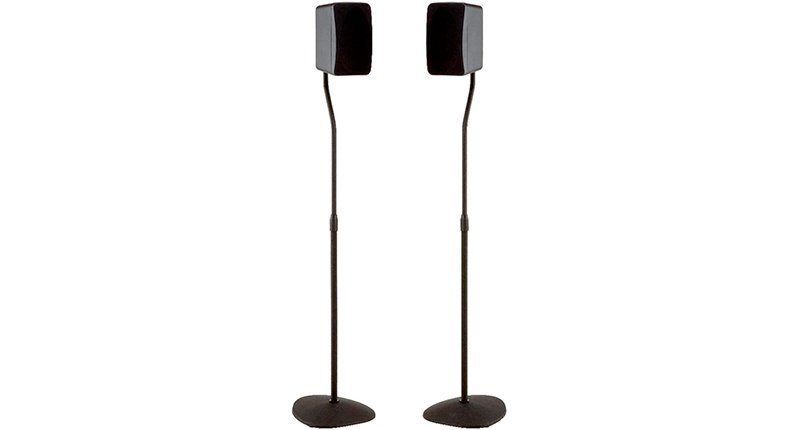
If you plan on arranging the surround sound set in your home theater with small speakers, these slim yet solid stands might be a key. They fit well for different positions, as the rear speaker stands, the front, or side ones. They’re easily regulated via a simple rotating fixator and can be positioned anywhere from 28 to 38 inches high. Still, these stands are designed for small-form lightweight speakers, from satellite to small bookshelf ones. They can also handle some bigger boxes so far as their weight doesn’t exceed 3.5lbs.
Another benefit of these stands is the diversity of mounting brackets and adaptors they can accommodate. They have a top plate with three bottom slots for screws radiating from the center and thus fitting a variety of bolt designs. The L-plate can fix the speakers with the vertical mounting pins / bolts. The T-shaped mount helps attach them firmly through vertical and horizontal slots.
Despite thin pillars, the stand feels durable. It’s made of steel and features a wide base of about 10 x 7 ¾ inches. The retainers are firm but yield to the medium rotation pressure. Pillars go straight and feature a deflection in the upper part making the construction well-balanced. Inside the pillars, there are cable channels hiding the wire from sight. The Sanus speaker stands provide a good value for money combining a sturdy construction and unusual design with multiple solutions for speaker mounting and cord management.
Pros
- Keep balance with any type of speaker mounting.
- The black coating of the stands, plates, and mounting plates is thick and feels smooth yet not slippery.
- Supplied adhesive pads secure the speaker additionally.
Cons
- The L-shaped mount provides little place between the speaker and the mount so that the connectors might not fit.
- The rods are too narrow to accept small-gauge cables.
Video Sanus HTBS
Atlantic PN77305018
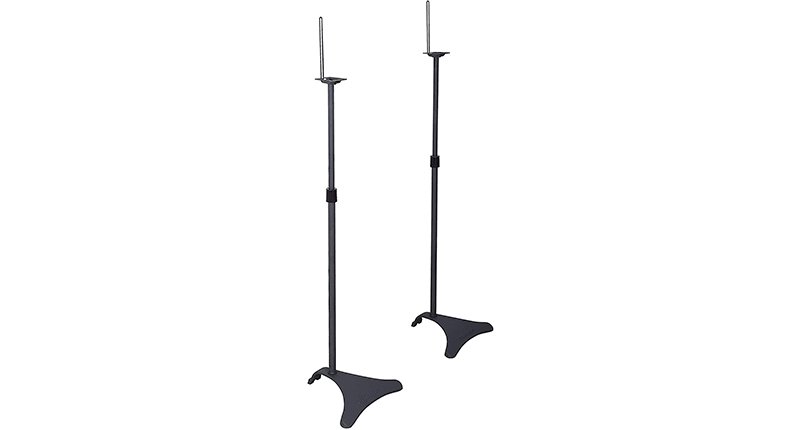
If you’re looking for cheap speakers stands for your satellites, the Atlantic PN77305018 should be on the comparison list. This model is compact and has different height positions, can hide your cables easily, and looks good as well. The coated aluminum bases and pillars and a simple adjustable mechanism lock speakers securely in place. The bases are curved and can additionally hide the wires underneath. The only downside I would mention is the small maximum weight carried by these props. It wouldn’t fit the speaker boxes of more than 2.5lbs, and that means only the satellite ones can be used with the stand.
This model is particularly good for enhancing a surround sound set. The stand rods can be adjusted within 19 inches, being positioned between 27 to 48 inches high. In this way, you can regulate the surround sound effect letting the speaker be directed onto the listener directly or put overhead, for more spacious sound. The collar is ribbed so that it’s easy to turn. Still, when removing the fixator, make sure to hold the upper rod, as it slides easily within the bottom one.
The total height of these surround sound speaker stands is 49.25 inches. The base is 11.5-inch wide and 10.5-inch deep providing a solid three-point support for the pillar and the speaker. The top plate is smaller and has the screw slots fitting the majority of speakers with bottom fixation.
Pros
- Curved metal supports fix the speakers in place and don’t interfere with the connectors.
- The base design lets put it under the couch or another piece of furniture; a good decision for small spaces.
- The base feet with no jointing letting you put it on a carpet, hardwood, and other floor covers.
Cons
- For some speaker models, bending the back support might be required to fit the box snugly.
- The logo parts on the bases are glued and tend to fall off upon the time.
Video Atlantic PN77305018
Perlesmith PSSS1
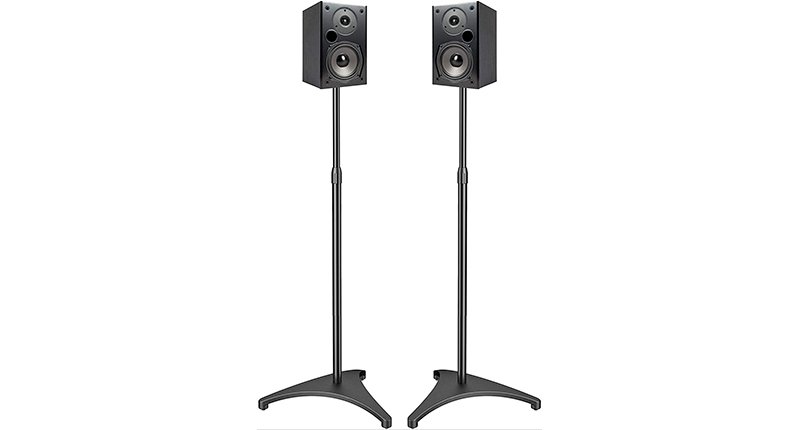
The setup of these stands is simple thanks to the user-friendly design and heavy-duty build. It gets assembled in a few minutes, and there’s a versatility of mount and adapters to fit almost any satellite or bookshelf speaker. The Polk Audio, Bose, JBL, Klipsch, Samsung speakers can be fixed on these stands without much fiddling with the wire, connections, and screws. A Phillips screwdriver is basically the only tool I used to install my Sony set on these stands (with the L-shaped mount). They could be the best speaker stands for any setup: a single speaker, a stereo pair, or a surround set, save for the triangular base form factor. It should be positioned so that two feet are behind the speaker, one foot is in the front. Otherwise, especially with bookshelves, the pillars would tend to tip over.
This model lets you put your drivers anywhere between 30 to 45 inches high from the floor. The construction features 3 tubes and responsive sliding mechanics. Releasing the retainer, extending the rod, fastening the retainer takes less than a minute. The tubes are quite wide and can be used to pass a thick high-quality speaker wire.
The mounting methods include the L-shaped, a keyhole mount, a horizontal adaptor with slots of different types of width, and a top plate position. The stands can hold up to 8lbs each, which makes them full bookshelf speaker stands. The base has three feet, with an 11.8-inch distance between the feet.
Pros
- Sturdy iron cast base and pillars.
- The retainer has wide recessions for the fingers ensuring easy rotation.
- The base feet can be fitted with nails or pads for stability on the carpet and smooth floor.
Cons
- Installation of the satellites with the single back hole requires fiddling with adapters and adjustments.
- The top opening for wire passing is slightly narrower than the rest of the tube and requires some hard pushing to make a thick cable go through it.
Atlantic PN77335799
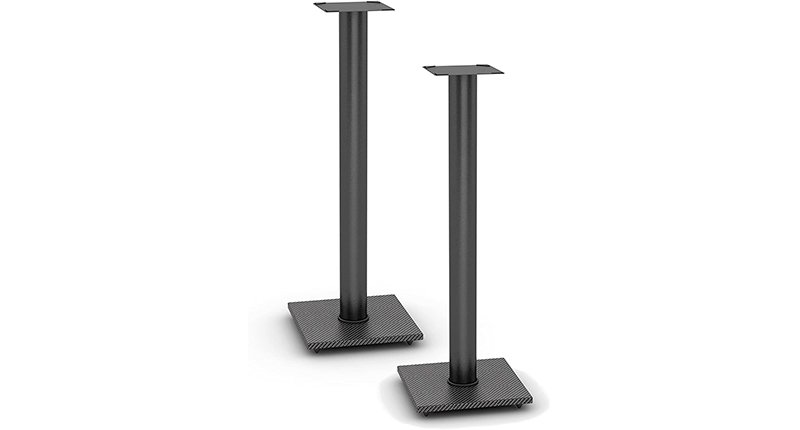
This model represents a speaker pedestal type of stand and provides a heavy-duty option for big bookshelf speakers. Each of the pillars can hold up to 20lbs and ensure stable positioning of the speakers thanks to the solid construction. The pillars are thick running up to 30 inches in height, and the bases are wide square plates (10.5 to 10.5 inches). The small cone feet on the bottom of the bases provide good adhesion to different floor surfaces including the lacquered parquet and fluffy carpets.
The construction is mainly made of steel and has a smooth matte finish. The pedestal and the top plate are black while the base is checkered making the design unique. The top plate can be used with two types of mounting hardware: the cone-like screws and adhesive triangles, all put in the corners of the plate. The adhesive tape pieces are quite strong and make a good option for multiple speakers not having the relevant bottom mounting holes.
The pillars have a wide opening on the back, which is easy to pass the cords through. With the base plate being slightly lifted, there’s enough room to run the cables up to the floor and then to the side or to the back of the stand.
Being adjustable speaker stands, they let tilt the box up to 45 degrees and customize the direction of the sound.
Pros
- Wide top plate (6 x 6 inches) accommodates the bookshelves of the different forms (square, tall rectangular, wide rectangular).
- The base is wooden (MDF) dampening the sound vibration.
- Quick to assemble, the column is fastened to the top plate with a single screw.
Cons
- The bottom spikes are a bit narrow and make the construction less stable with the speakers heavier than 12lbs.
- The plates and the column are slightly misaligned, which causes wobbling when there’s no speaker set on top.
Video Atlantic PN77335799
VideoSecu MS07B2 — Best DJ Speaker Stand
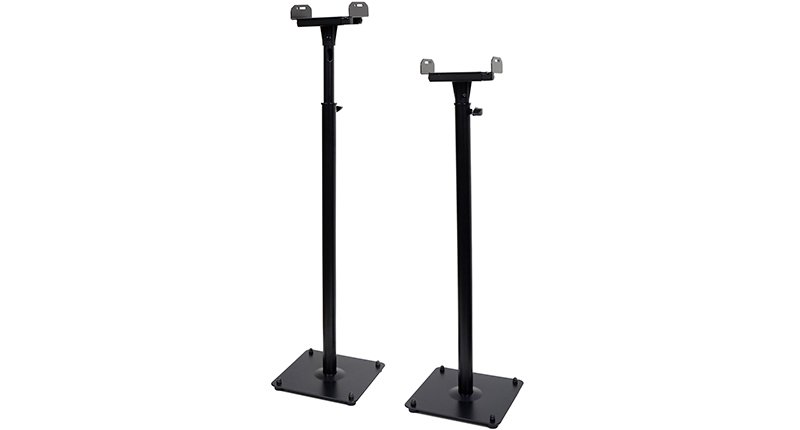
These sturdy floor speaker stands are versatile and can fit speakers of various sizes and forms. The wide heavy platforms and thick pillars make these stands hold up to 30lbs weight. Besides, they’re equipped with adjustable top plates. This means that almost any kind of bookshelf and satellite speaker with bottom fixation can be secured on the stand. Sony, Samsung, Harman Kardon, Klipsch, Pioneer, KEF, Elac, and other brands fit well, moreover, because of the lack of back support (and no restrictions for the connectors / wire).
The bottom platforms are squares with a 7.5-inch side. They have a screw in each corner that nails into the trapezoid rubber pads. These rubber feet don’t ruin the hardwood floor. On the platform, there’s a circular gasket fixing the stand rod. The latter consists of two tubes and is wide enough to accommodate the RCA cables inside. The cables are inserted into the tall opening in the upper part of the speaker stands.
The top platforms represent a square plate with two side retainers that can be extended. Thus, the stand can hold the speaker from 5.5-inch to 11-inch width. The top plates can rotate up to 180 degrees, which is handy for setting up the optimal sound stage within a home theater, as well as directing the speakers during stage concerts / DJ gigs. The position can be also adjusted by height: you can put your stereo or surround set anywhere from 26.5 to 47 inches high.
Pros
- Durable all-steel construction and expensive-looking smooth black finish.
- The height is easy to regulate with the turning peg.
- The side supports also feature the holes for additional speaker fixation.
Cons
- The bottom rubber pads are small, and the stand is somewhat wobbly even with the lightweight speaker on top.
- The power cord of a big speaker may not fit inside the stand rod.
Mounting Dream MD5401
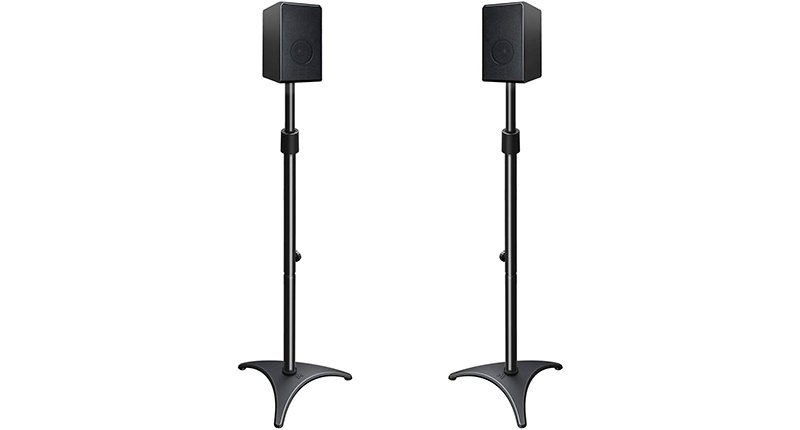
With multiple attachment methods and comfort options, these tall speaker stands represent the universal solution for the majority of small-sized speakers. They can hold a speaker with the bottom fixation, the backside mounts of different styles and shapes, and even a wooden speaker with no screw openings. They can also position your sound boxes as high as 48 inches, creating the three-dimensional audio effect. Still, should you like to accommodate a stereo set on them, at the comfortable level, there’s the adjustable mechanism letting you put your speaker at 35.5 inches from the floor.
The construction is sturdy and well-assembled. The elements are made of cast iron and feel thick and reliable. All the joints are steady, there’s no wobbling or slack connection. The bottom base is performed in a triangular shape, with three points of contact with the floor. The feet are thick on ends ensuring the stability of the stand. With the speaker up to 11lbs weight, there should be no problem with weight balance in these speaker stands.
The top plate of the stand is round-shaped and has four holes for the bottom mounting fixation. It’s equipped with the back support, which can be extended in length to accommodate a larger box (up to 6.5-inch base). The back support is enhanced with the horizontal adaptor that can be put anywhere on the support (from 1.6 to 8-inch height). This means the tall bookshelf speakers (up to 10 inches) are also acceptable.
Pros
- Two-step height adjustment includes a side peg and an on-the-rod collar.
- The horizontal adapter has the turning peg fixation system and is easy to regulate.
- Supplied cable ties let pass the cord through the tube quickly.
Cons
- The adjustment knobs are plastic and might break under the pressure.
- The L-bracket stands in a way if you want to use the banana plugs on the speaker.
Stageek PRO — Best Studio Speaker Stand
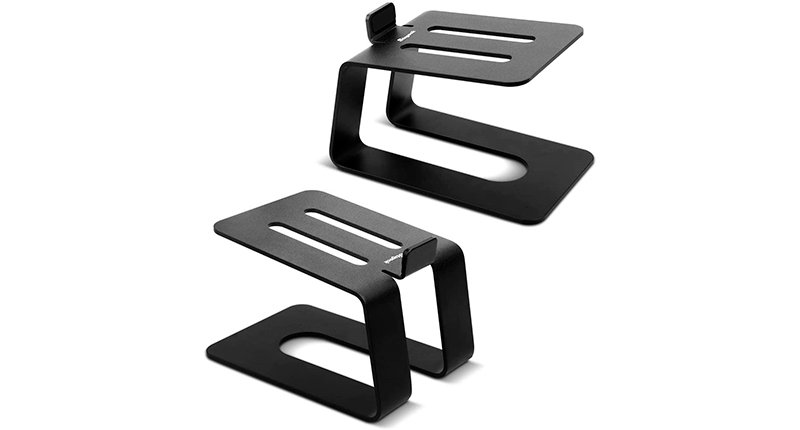
The minimalist design of these short speaker stands turns out quite versatile in functionality. These platforms can hold a variety of satellite, desktop, or bookshelf speakers up to 6.5 inches wide and weighing no more than 15lbs. They’re also well portable and can be moved around easily. However, the height and other parameters cannot be regulated, which means a limited area of use.
The base plate is longer than the top one being 7.28 inches. The top platform is 6.3 inches long. The platform holds a speaker at a 4.72-inch height above the desk or another surface you’ve put it on. The upper platform has a slight upwards tilt (about 5 degrees) positioning the speaker so that the sound wave is directed onto your ear level if you sit at the desk. The speaker is secured from sliding with the small support in the center of the back side of the stand. Two long slots within the top plate let you bottom screw the speaker on the plate.
These unusual stands for speakers can function as the space-savers for the cluttered desks. Rising the speakers, they allow putting things under and around the speaker without risking to push it away or scratch. They’ll definitely find their place at the gamer’s setup, in the sound studio, and even on the TV shelf.
Pros
- The aluminum build makes the stands solid yet lightweight.
- The construction has a small spring effect and hushes the resonance and vibration both ways.
- The bottom plate has an L-shaped soft pad at each corner leaving the desk untouched and damping the vibration.
Cons
- Get slightly bent under the speakers heavier than 12lbs.
- No side supports.
Echogear EGAV-SFSSP
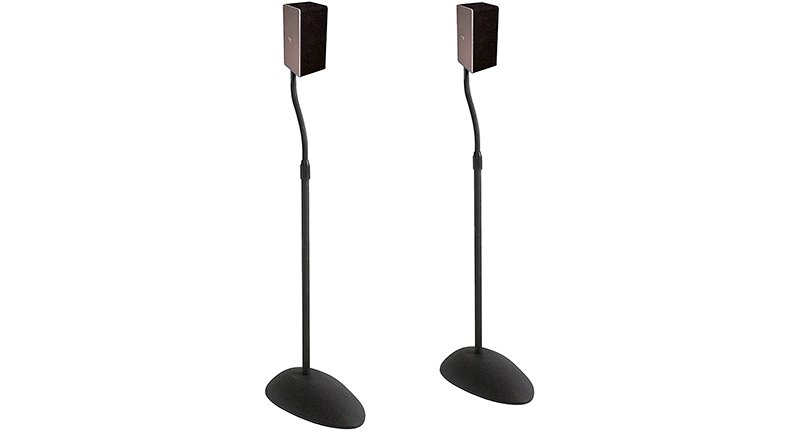
If you aim for a clean sound in your surround sound setup, have a look at these satellite speaker stands. They’re made of steel and absorb the sound vibration efficiently. The resonance is also cut by the bulky bottom plates (11.8 inches long).
The stands represent the two-tube rods curved on the top. The ribbed collar under the curved part releases the upper tube and lets you push it up or down placing your satellite box between 27 and 38 inches. The rods are sturdy and are additionally stabilized with a heavy bottom platform. Not exceeding the recommended speaker’s weight (4lbs), you’re unlikely to have these holders tipped over, even in the places of moderate traffic.
The mounting brackets are fixed to the steel rod with a single Philips screw. There are three ways to secure the sound box on this speakers stand: placing it on top and screwing it to the platform; using the L-bracket and the single-hole mount. The latter is fixed with the rotating peg, which makes the installation quick and simple. This set of stands can hold the majority of Klipsch, Sony, and Bose gear, and some Vizio satellites as well.
The set includes the cord management system letting you pass the cables through the tube and beneath the bottom platform. Like in most satellite stands, this unit’s tubes might be too narrow to pass through the small-gauge wire. Still, the construction features the cable loops helping keep the wire close to the stand.
Pros
- The lower rod part has the thread on the bottom and is screwed into the base.
- Can be put on any type of floor thanks to the rubber pads and metal spikes supplied.
- A comprehensive and detailed manual makes the setup fast.
Cons
- The slots in the mounting brackets are small; might not fit some particular speaker models.
- A grainy finish of the pillars and bases tends to pile dust.
Perlesmith PSSS6
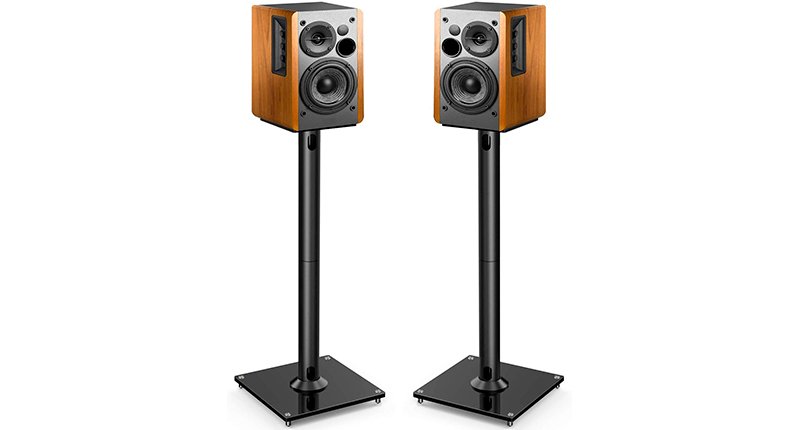
The design of these premium stands for speakers provides for the efficient cutting of vibration and lets the speakers visually and acoustically dominate over the room. All elements are sturdy and have a glossy expensive-looking finish. The stand is made of metal and glass and weighs almost 16lbs providing stable speaker support. However, its construction is simple, and takes a few minutes to assemble.
The pillar is 26-inch high and 1.96-inch wide, made of thick metal. It’s hollow inside so that the cords can be placed within the tube. The cables are threaded in and out through the big windows (0.78 x 1.37 inches) near the top and bottom plates. The 12-gauge wire fits them well, and even the bulky RCA connectors don’t get stuck within.
The total height of the music driver placement on this stand makes 27.5 inches, which is fine both for sitting on the couch and standing during the parties. The bottom and top plates are squares with the size of 11.8-inch and 7.79-inch accordingly. The overall construction of these speakers stands feels rock-solid while the manufacturer recommends using it for speakers weighing up to 22lbs.
The speaker is fixed on top with the self-adhesive pads located in the corners of the plate. Peel off the upper layer, and put the speaker on the platform — the installation is over. The absence of built-in brackets and other supports makes the stand compatible with any speaker brand within the mid-size range.
Pros
- Silicone pads on the bottom feet are thick and wide ensuring the stable position on tile and hardwood.
- The supplied mount tilts the speaker for 45 degrees.
- The speaker fixing pads are shockproof.
Cons
- No adjustable mechanisms.
- The lower cable window is located on the pillar making the cords visible.
Bose FS-1
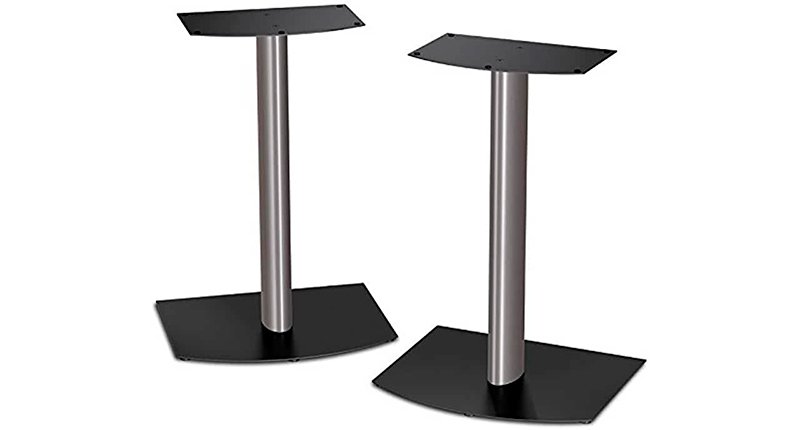
The precise alignment and highly stable construction let the Bose speaker stands easily accommodate the largest of the bookshelf speaker models, like the Bose 301 series. The unusual shape of the plates (trapezoidal with the curved upper part), thick material, and simple operation make it a good choice for the home theater setup or any other stationary usage.
The speaker on this stand sits at 24-inch height. Its base plate is 11.5-inch wide and 7.25-inch deep. The stand’s weight is about 20lbs while the speaker’s weight might reach 38lbs. Assembling the stands doesn’t require special skills; the parts are a few, and the joints are obvious and simple to attach.
The pillars are slimmer in front and wider from the side. There’s the cord channel inside the pillar, which is reached through the wide hole on the back of the pillar.
The mounting method for this stand is the top plate positioning. While there are no brackets and mounting screws, the exact straight positioning and a solid weight let the stand hold any music driver reliably.
Pros
- A smooth matte finish and black-and-gray palette make the stand fit the variety of interior designs.
- The base has low-profile rubber pads fit for solid floors.
- Supplied adhesive pads let you glue the speaker to the stand.
Cons
- The assembling screws are tight and can be stripped under high pressure.
- May sway on occasional bumps.
Buyer’s Guide
The Reason to Buy Speaker Stands
If you’re tired of placing your speakers on books, moving them around, and occasionally knocking on them now and then, the dedicated stands will solve the issue. Another benefit is the improved sound of the standing alone speaker not affected by the surrounding objects. The stands are designed to damp vibration and thus, provide for clearer sound output.
Useful Tips and Tricks of Maintenance
- Clean the stand with the speaker dismounted.
- Use a soft cloth to remove dust and dirt from the stand.
- Don’t apply aggressive chemicals, abrasive sponges, or excessive water.
- Upon cleaning with the moist cloth, wipe the stand thoroughly with the dry one.
- To avoid scratches, don’t place the stand tight under the furniture.
Speaker Stands Features
Size, design, and cost of the stand you’re planning to put your speaker on are the most important parameters to consider when choosing a speaker stand. However, for comfortable use, you should also bear in mind the following features.
Best Height for Speaker Stands
Placing the speakers at the correct height is not just a matter of the user’s comfort. In order to hear all of the sound peculiarities and get balanced audio you’ve got to have the speaker center positioned on a level with your ears. That’s why it’s important to consider what you’re going to use the stand for. If you‘re going to mount your home theater set at the optimal height, first mark your listening position (e.g. on the couch) and then find the stand placing the speaker at that height (usually about 26-30 inches from the floor). For parties, public events, stage concerts the higher positioning is required (the stand’s height should be no less than 40 inches).
Adjustable stands provide flexibility, as you can change the height at your preference. Buying an adjustable stand, make sure it encompasses the height you need, and that the regulating collar, peg, or another mechanism is working well. With the majority of the modern stands, you won’t need a specific tool to change the speaker’s level.
Top Plate
That’s the place where the speaker actually stands. The top plate can be flat or feature a small (about 5-10 degrees) tilt in order to direct the speaker onto the listener’s ear level. In some models, the top platform position can be adjustable up to 45 degrees. Though the majority of stands have stationary plates, some can feature regulated ones letting you put smaller or bigger speakers on them.
The top plate might be equipped with several appliances to keep the speaker in place. These are rubber pads, adhesive spots, side and back supports, the holes and slots for screw mounts. Some models are enhanced with various adapters aiming to cover the majority of speaker models.
Base & Feet
The base plate is important, as it secures the stability of the whole construction. It should be wide enough and heavy, preferably with even height distribution. The more stable the base, the heavier the weight of the speaker can be accommodated on the top plate of the stand.
The base can have a different design. It can be a flat plate (square, rectangular, trapezoidal, etc.) or a triangular, rectangular curved one with three or more feet. The feet usually have rubber or plastic pads for non-marring the hardwood floors, and metal or plastic spikes for stable positioning on the carpet.
Cable Management
In many models, there’s a hollow tube inside the stand pillar for passing the speakers cables through it and having them come out at the base or even under the bottom of the stand. This makes the whole setup look clean, without hanging cords.
If you need cables to be hidden, consider the gauge of the speaker wire you’re using, the number of cords, and their total thickness. Then see if the cable opening in the stand fits the speaker wire.
Another way of cable management is by using the velcro straps and attaching the cords behind the pillar.

Hi everyone! I’m Thomas Moody, also known as Guitarzan.
